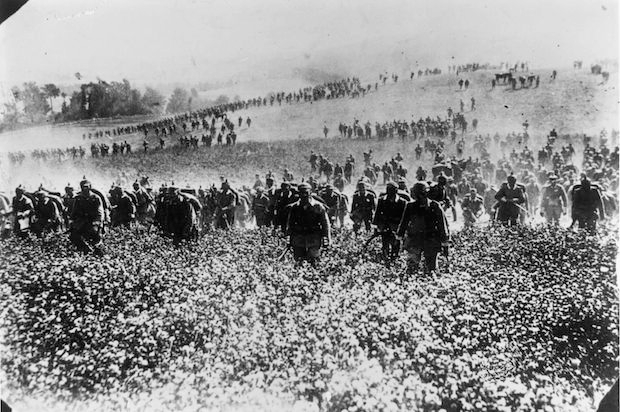From The Spectator, 19 September 1914:
ON September 5th we wrote: “We and the French have got the wolf by one ear and the Russians have got him by the other, and though he may use his teeth with terrible effect, if we have the hardihood and patience to hold on we shall finish him in the end. And we shall have the hardihood and the patience.” It was perhaps premature to write that a fortnight ago, but at the present moment it represents the situation pretty accurately. During the past week the wolf has been struggling specially hard to drag his head out of French and British jaws, but he has not yet succeeded. As we write his paws are planted firmly on the river Aisne, and he is making a desperate effort to wrench himself free. If he succeeds, he will either retreat to rest before making another leap, or else he will at once begin another rush forward, when we and the French will again have to catch and hold him. This is the state of the war at the moment, but so quick are the changes that ours may be an altogether out-of-date presentment of the situation in the western theatre of the war before these pages reach our readers’ hands. To abandon metaphor, what has happened since our previous issue is that the movements the beginnings of which we chronicled as we wrote on the morning of Friday week have developed, as we believed they would develop, not into a ruse de guerre to draw us on, or into a concentration on the centre which would enable the Germans to break through the French line en masse, but into a decided movement to the rear. The Germans have retreated along the whole of their line, which once stretched from Verdun to the environs of Paris, or rather have undertaken a swinging movement with a position a little north of Verdun as the pivot, a movement involving, of course, a much wider sweep, and so a much greater giving of ground on the German right than on the centre or the line near the pivotal point. The Germans have already evacuated Amiens, Soissons, Rheims, and Nancy, and, speaking generally, hold the line of the Aisne. While the Germans were falling back from the line of the Marne the French and British attacked them vigorously, and thus there was almost an exact repetition of what happened when we and the French had to fall back after the battle of Mons to the line Paris-Verdun. In the earlier part of the German retreat the Germans lost a great many guns and prisoners, and there was a good deal of confusion, and probably a shortage both of food and ammunition. Gradually, however, the Germans, with their wonderful discipline and power of organization, re-established their line, and by vigorous, and in many cases heroic, counter-attacks held back their pursuers while the main part of their Army got away and created a series of entrenched positions along the Aisne.





Comments